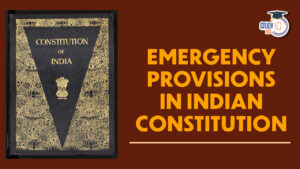Table of Contents
All India Judicial Service (AIJS)
The idea for an All India Judicial Service (AIJS) began in 1961 to ensure that judicial appointments are free from interference. Though initially opposed by some states and courts, it gained traction in 1976 when the Constitution was amended to allow for its establishment under Article 312. A proposal by the UPA government in 2012 was also shelved after concerns from a High Court Chief Justice.
All India Judicial Service which is covered in this article is covered in the Indian Polity and Governance of UPSC Syllabus. Students can also go for the UPSC Mock Test to get more accuracy in their preparations.
We’re now on WhatsApp. Click to Join
All India Judicial Service History
In its original version, the Indian Constitution did not contain any provisions about the AIJS, but the Drafting Committee eventually produced Article 235, which places the lower judiciary under the supervision of the High Court. The history of the AIJS has been lengthy and complex, with the Law Commission first recommending it in 1958. The aim is to create a centralized system for hiring district judges, transferring these powers from higher courts to a national body, similar to other competitive exams in India.
The AIJS aims to fill vacancies in the judiciary and ensure quality candidates. It proposes that 40% of positions come from promotions of subordinate judges, 40% from direct recruitment, and 20% from experienced lawyers. The Supreme Court has supported the establishment of the AIJS, citing its necessity.
The AIJS will include candidates aged 28 to 35, with qualifications that allow lawyers and teachers from recognized law institutes to take the exam. However, high courts have shown resistance to this idea due to concerns about losing control over appointments. As a result, the proposal has faced mixed reactions from states and judicial bodies.
The Swaran Singh Committee recommended adding judicial services to Article 312 in 1976, but this only included district judges and not lower-ranking positions. The idea of an All India Judicial Service was discussed at Chief Justice Conferences in 1961, 1963, and 1965 but was dropped due to objections from some states and High Courts, which were concerned about losing their hiring powers for lower-level judges. In many states, either the state High Courts or Public Service Commissions handle these lower judicial appointments.
Timeline of All India Judicial Service
| Year | AIJS Recommendations | SC’s Stand on AIJS | Centre’s Action |
| 1958 | Law Commission proposed a ‘Centralised Judicial Service’. | ** | ** |
| 1978 | Law Commission reiterated the idea of AIJS to address case backlogs and judicial appointment delays. | ** | ** |
| 1992 | ** | Supreme Court directed the Centre to establish AIJS (All India Judges Association vs Union of India). | ** |
| 1993 | ** | Supreme Court authorised the Centre to independently initiate the creation of AIJS. | ** |
| 2006 | Parliamentary Standing Committee on Personnel, Public Grievances, Law, and Justice advocated for a pan-Indian judicial service and drafted a bill. | ** | ** |
| 2012 | ** | ** | Centre proposed a “comprehensive proposal for AIJS”, endorsed by the Committee of Secretaries. |
| 2013 | ** | ** | AIJS was included in the agenda of the Conference of Chief Ministers and Chief Justices of the High Court, but no consensus was reached. |
| 2017 | ** | Supreme Court proposed a “Central Selection Mechanism” for appointing District Judges. | AIJS discussed in the Chief Justices Conference; decision to allow High Courts to devise methods to appoint district judges within the existing system. |
Also Read: National Legal Services Authority
View of Judiciary on All India Judicial Service
In the 1991 case of Union of India v. All India Judges’ Association (1), the Supreme Court ordered the Centre to establish an AIJS. However, the court freed the Centre to take the lead on the matter in a 1993 review of the ruling.
In 2017, the Supreme Court proposed a “Central Selection Mechanism” to address the issue of district judge appointments. The court selected senior attorney Arvind Datar as an amicus curiae, and he sent a concept note to all the states recommending a common exam rather than separate state exams. High Courts would then conduct interviews and appoint judges based on the merit list.
Also Read: Lok Adalat
All India Judicial Service and Objections Implemented
The independence of the judiciary would be compromised if the Union government gained control of the state courts through AIJS by abolishing the High Court, as now allowed by Article 235. With the exception of a few National Law Universities, law school curricula lack effective standards, which lead to poor-quality legal research and academics. This issue is not addressed by AIJS.
Concerning the level to which postings should be included in the Indian Judicial Service, there is a lack of agreement and uncertainty. AIJS officers would find it difficult to become accustomed to the local language, which would impede the administration of justice in courts where business is conducted in the state language up to the District and Sessions Judge Level. If officers at senior levels are taken through AIJS, avenues for promotion for those who had already entered through the state services would be limited, which will have an impact on the staffing of the State Judicial Service.
A “national exam” could prevent people from less affluent backgrounds from joining the legal profession. The issue of disproportionately low compensation, the absence of proper judicial infrastructure (including courts or training for officers) in the states, or the lack of career advancement is not addressed by AIJS.
Less than one-third of seats in the High Courts are held by judges from the district cadre, despite the fact that the first two are the responsibility of State governments and the latter is the responsibility of the judiciary. Despite this, no adjustments have been made to ensure better district judge representation in the High Courts. The issue of local laws, practices, and customs that differ greatly between States is ignored by AIJS, which raises the price of training judges chosen by the method.
Constitutional Framework For All India Judicial Service
| Constitutional Provisions |
|
Existing Judicial Recruitment Process
- District Judges (Article 233): Appointment is made by the state’s Governor based on consultations with the High Court of the respective state.
- Subordinate Judicial Officers (Article 234): Recruitment for positions below district judge is done by the state’s Governor, following rules established in consultation with the State Public Service Commission and the High Court.
Benefits of the Existing System
- Promotes Diversity: Current recruitment methods through High Courts and public service commissions better accommodate diversity, including reservations, and align with local practices.
- Practical Experience Preference: Lawyers often opt for judicial service based on practical experience. The current system is seen as more accommodating to this approach.
Need for AIJS
- Judge Vacancies: There are about 5,400 vacant positions in the lower judiciary, contributing to a backlog of 2.78 crore cases, mainly due to delays in state exams.
- Quality of Judicial Officials: The declining quality of judges can slow down justice delivery, increase case backlogs, and negatively impact higher courts’ effectiveness.
- Budget Constraints: State judicial services struggle to attract top talent because of low salaries and benefits offered by state governments.
- Lack of Specialized Training: There are not enough modern training institutes for judges, limiting interns’ exposure to specialized education.
- Narrow Selection Process: Choosing judges should not rely solely on a small group (the collegium) but should be a broader and fairer process.
- Timely Recruitment: AIJS will help quickly fill judge vacancies across the country, ensuring judges are placed where they are most needed.
- Improved Court Efficiency: Faster hiring of judges through AIJS will reduce delays in processing cases in district and subordinate courts.
- Better Judicial Administration: AIJS aims to attract top talent, maintaining high standards in the judiciary.
- Reduced Nepotism: AIJS can decrease issues of corruption and favoritism in judge appointments, helping restore public trust in the judiciary.
- National Integration: AIJS will facilitate the appointment of talented judges from different states, promoting resource sharing.
- Representation for Marginalized Groups: The recruitment process will include reserved positions for underrepresented communities, ensuring diverse representation in the judiciary.
Advantages of All India Judicial Service
Following are the Advantages of All India Judicial Service:
- A judicial career will promote accountability and professionalism in the judiciary.
- Open competition will reduce bias in the selection process for judges.
- AIJS will create a fair recruitment method, helping to draw in the best legal professionals and allowing for earlier promotions to higher courts.
- It will ensure consistent quality in justice across the country by standardizing laws and practices.
- A streamlined hiring process will help fill vacancies quickly with qualified judges, leading to faster case resolutions.
- AIJS will enhance diversity in the judiciary by hiring trained officials from underrepresented groups, including women and SC/ST communities.
- A well-structured judicial service will attract young, knowledgeable officers, making the court system faster and more effective.
Challenges with Centralization of Judicial Service
- Constitutional Hurdles: Implementing a centralised judicial service would require overriding state-specific rules, potentially conflicting with the Constitution’s recognition of states’ authority over their subordinate judiciary.
- Federal Structure Concerns: Many states may resist centralization, viewing it as an encroachment on their jurisdiction, thereby potentially weakening the federal structure.
- Lack of Uniform Agreement: The proposal lacks widespread support, with only two High Courts in favour and 13 opposed. Disagreements persist over eligibility, age, selection criteria, qualifications, and reservations.
- Language Barrier Issues: The challenge of linguistic diversity, particularly in lower courts where local languages are predominant, raises questions about the feasibility of judges from one region effectively serving in another.
All India Judicial Service Criticism
The policy faces several issues that have led to mixed reactions from legal experts. One main concern is the age and experience requirements for the exam. The seven-year experience needed could discourage young graduates, as most finish their studies between 24 and 26 years old. This means a 31- to 33-year-old would be competing against younger candidates at the same level.
Another issue is the language barrier, especially in non-Hindi-speaking states where English is not widely used. While the government has tried to address this by allowing for 22 languages listed in the Constitution, the problem of interstate appointments remains unresolved.
According to the Ministry of Law and Justice, there are 24,018 sanctioned judicial positions in India, with 5,146 currently vacant. High Courts like Allahabad, Patna, and Madhya Pradesh account for 42.7% of these vacancies. Vacancies are more prevalent in subordinate courts than in district courts. Thus, the AIJS will only address a small portion of the overall vacancies, and changing the current judicial structure could lead to negative outcomes.
Way Forward for AIJS
- Addressing Judicial Vacancies: AIJS is proposed as a solution to the persistent issue of unfilled judicial positions.
- Enhancing Bench Diversity: It aims to improve representation of marginalised groups within the judiciary.
- Attracting Quality Candidates: The service is envisioned to draw the best legal talents, akin to other prestigious civil services.
- Structural Design Needs: For AIJS to be effective, it must be meticulously designed to overcome potential shortcomings.
- Large-Scale Recruitment: Similar to civil services like IAS, IPS, and IFS, recruiting judges in significant numbers through AIJS could effectively reduce the current shortage in the judiciary.
All India Judicial Service UPSC
The construction of a recruitment mechanism that attracts effective judges in large numbers is required due to the overwhelming volume of cases that need to be resolved. Building consensus and taking meaningful action in the direction of the AIJS are necessary before the AIJS enters the legislative framework, nevertheless. Students can read all the details related to UPSC by visiting the official website of StudyIQ UPSC Online Coaching.


 Indian Secularism: Constitutional Provis...
Indian Secularism: Constitutional Provis...
 India Mediation Campaign, Objectives, Pr...
India Mediation Campaign, Objectives, Pr...
 Emergency Provisions in Indian Constitut...
Emergency Provisions in Indian Constitut...





















